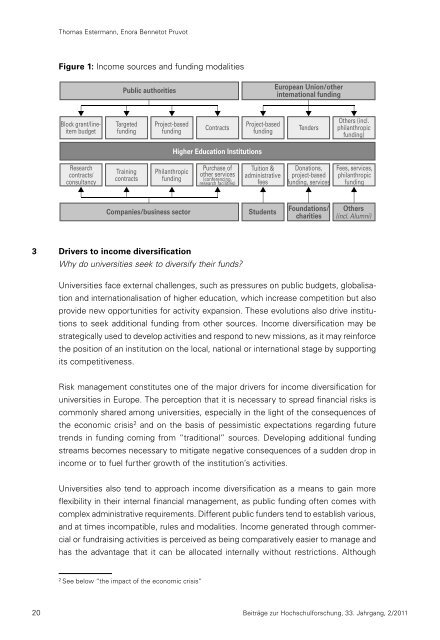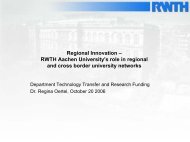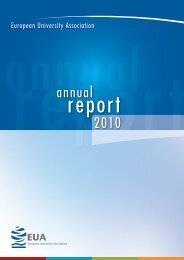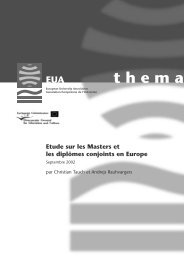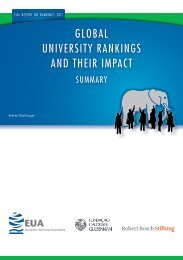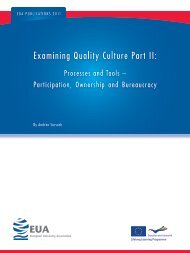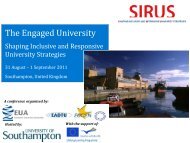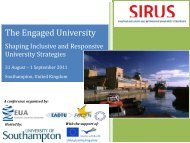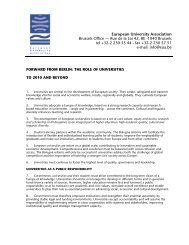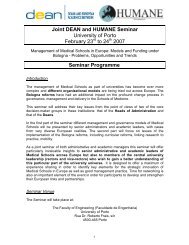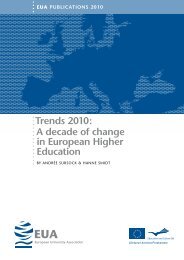Beiträge zur Hochschulforschung - European University Association
Beiträge zur Hochschulforschung - European University Association
Beiträge zur Hochschulforschung - European University Association
Create successful ePaper yourself
Turn your PDF publications into a flip-book with our unique Google optimized e-Paper software.
20<br />
Thomas Estermann, Enora Bennetot Pruvot<br />
Figure 1: Income sources and funding modalities<br />
Block grant/lineitem<br />
budget<br />
Research<br />
contracts/<br />
consultancy<br />
Public authorities<br />
Targeted<br />
funding<br />
Training<br />
contracts<br />
Project-based<br />
funding<br />
Philanthropic<br />
funding<br />
Companies/business sector<br />
3 Drivers to income diversification<br />
Contracts<br />
Higher Education Institutions<br />
Purchase of<br />
other services<br />
(conferencing,<br />
research facilities)<br />
Why do universities seek to diversify their funds?<br />
Project-based<br />
funding<br />
Tuition &<br />
administrative<br />
fees<br />
Students<br />
<strong>European</strong> Union/other<br />
international funding<br />
Tenders<br />
Donations,<br />
project-based<br />
funding, services<br />
Foundations/<br />
charities<br />
Others (incl.<br />
philanthropic<br />
funding)<br />
Fees, services,<br />
philanthropic<br />
funding<br />
Others<br />
(incl. Alumni)<br />
Universities face external challenges, such as pressures on public budgets, globalisa-<br />
tion and internationalisation of higher education, which increase competition but also<br />
provide new opportunities for activity expansion. These evolutions also drive institu-<br />
tions to seek additional funding from other sources. Income diversification may be<br />
strategically used to develop activities and respond to new missions, as it may reinforce<br />
the position of an institution on the local, national or international stage by supporting<br />
its competitiveness.<br />
Risk management constitutes one of the major drivers for income diversification for<br />
universities in Europe. The perception that it is necessary to spread financial risks is<br />
commonly shared among universities, especially in the light of the consequences of<br />
the economic crisis 2 and on the basis of pessimistic expectations regarding future<br />
trends in funding coming from “traditional” sources. Developing additional funding<br />
streams becomes necessary to mitigate negative consequences of a sudden drop in<br />
income or to fuel further growth of the institution’s activities.<br />
Universities also tend to approach income diversification as a means to gain more<br />
flexibility in their internal financial management, as public funding often comes with<br />
complex administrative requirements. Different public funders tend to establish various,<br />
and at times incompatible, rules and modalities. Income generated through commer-<br />
cial or fundraising activities is perceived as being comparatively easier to manage and<br />
has the advantage that it can be allocated internally without restrictions. Although<br />
2 See below “the impact of the economic crisis”<br />
<strong>Beiträge</strong> <strong>zur</strong> <strong>Hochschulforschung</strong>, 33. Jahrgang, 2/2011


